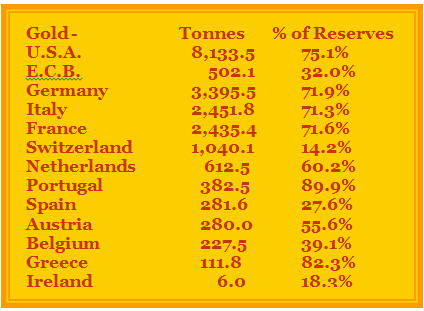Is Central Bank buying just a driving force behind gold or much, much more!
Since 2009 we have seen the signatory central banks of the Central Bank Gold Agreement cease selling their gold. We have stated many times in the past that the entire exercise of selling gold by these European central banks was to support the birth and establishment of the euro. They felt this was achieved by 2009, 10 years after the launch of the euro.
In the same year we saw the arrival of emerging nation’s central banks into the gold market as buyers. Since then they have set a pattern of buying gold that continues as a driving force behind the gold price even today. In this article we look at these events and other monetary developments in the gold market to see what to expect in the days and months ahead.
Which Central banks are buying gold and why?
As you have seen in our newsletter in the Table of central banks buying and selling gold it is the emerging nation’s central banks, whose reserves have been growing strongly that have led the way in buying gold for their reserves. Their aim is to diversify away from the U.S. dollar and other leading world currencies and to buy gold as a counter weight to those currencies.
These central banks are based in Asia, the Middle East, South America, etc. They include:
Russia – Bangladesh – Philippines – Saudi Arabia – Thailand – Belarus – Venezuela – India – Sri Lanka – Mauritius – Mexico – Bolivia – Colombia – South Korea – Turkey – Kazakhstan – Tajikistan – Serbia – Ukraine – Mongolia – Malta – Greece – Argentina.
The underlying reason why all of them are buying and why the European signatories to the Central Bank Gold Agreement stopped selling is because they all consider gold to be an important Reserve Asset and as the head of the Bundesbank put it, “gold is a counter to the swings of the dollar”. Neatly put, but isn’t there more to this than simply countering the swings of the dollar. Since gold was at $300 an ounce in 1979 right through to 2005 gold has been at that level or higher. Now it is at $1,660 five and a half times higher and the dollar is not five and a half times lower than other currencies. Gold has risen in all currencies including the euro which was well below €300 to an ounce of gold and is now at €1,321 more than four times higher than then. It has risen from $35 an ounce since the sixties a rise of 47 times!
Clearly, gold adds further ingredients to national reserves as these numbers demonstrate in part. The emerging world is as aware of gold’s value in their reserves as are the developed world’s central banks and are doing something about it before there are potentially devastating developments in the global monetary system.
Why do the central banks of the U.S., Germany, France and Italy hold 70%+ of their reserves in gold?
Having stated that they were sellers of gold from 1999 onwards through until now, Europe’s signatory central banks to the CBGA gave the impression before 1999 that their gold holding weighed heavily above the gold market. This combined with accelerated mining of gold then as the price was dropping, forced the gold price down and pushed the developed world to more and more dependence of the dollar then the euro. But in reality central banks were not trying to get rid of their gold  holdings. Some aimed at selling 20% of their reserves in total, while others like Germany, did not sell any of their gold, despite being signatories to the agreement. Some like the U.K. and Switzerland appeared to gullibly sell half of their reserves.
holdings. Some aimed at selling 20% of their reserves in total, while others like Germany, did not sell any of their gold, despite being signatories to the agreement. Some like the U.K. and Switzerland appeared to gullibly sell half of their reserves.
Then in 2009 all the signatories stopped selling except for small amounts for the minting of gold coins. This left the holding of European banks at these levels: –
For such an archaic reserve asset, it is doing very well in terms of its price moves. But the governments of the developed world knew that if their 40-year long experiment with un-backed paper money were to go wrong then gold could come to their rescue and, my goodness, it has!
The now incumbent money managers may well feel surprised at the way we have described currencies [as an experiment?], but since Nixon cut the link of gold to currencies back in 1971 that’s what we’ve had. Now, the money experts and leaders of the world, looking at the way governments across the developed world have abused this paper money and particularly national debt levels, they too can see the sinking level of confidence in such money both inside and outside the developed world. What can pull them from the brink of disaster if confidence in the two leading developed world currencies [and leading reserve currencies] collapses? What can pull the world’s leading commercial banks, particularly those fused at the hip to government [in their asset portfolios], from collapse?
Having watched the credit crunch morph into the Eurozone debt crisis and potentially return across the Atlantic by year’s end to see the U.S. once again fighting over-indebtedness, developed world central and commercial banks realize that whatever their dislike of the discipline of gold and its unmanageability, it will allow them to harness a confidence that currencies are failing to do. Gold is also facilitating loans and liquidity that goes far beyond its price.
The structural benefits of gold are now showing clearly in gold and the need to side-line it from the monetary system is now proving a dangerous handicap for the monetary system. Hence Basel III discussion taking place now, to be implemented from January 1st 2013.
In the second part of this article we look at: –
– Basel III and its implications for gold and its price.
– How gold is returning to the monetary system right now in the banking system.
– Will the ‘powers-that-be’ continue to allow gold to be privately owned [including in gold ETFs?
– How can you protect yourself against confiscation of gold, even if held in Switzerland or elsewhere?
Get the rest of the article & more!
Subscribe @
Legal Notice / Disclaimer
This document is not and should not be construed as an offer to sell or the solicitation of an offer to purchase or subscribe for any investment. Gold Forecaster – Global Watch / Julian D. W. Phillips / Peter Spina, have based this document on information obtained from sources it believes to be reliable but which it has not independently verified; Gold Forecaster – Global Watch / Julian D. W. Phillips / Peter Spina make no guarantee, representation or warranty and accepts no responsibility or liability as to its accuracy or completeness. Expressions of opinion are those of Gold Forecaster – Global Watch / Julian D. W. Phillips / Peter Spina only and are subject to change without notice. Gold Forecaster – Global Watch / Julian D. W. Phillips / Peter Spina assume no warranty, liability or guarantee for the current relevance, correctness or completeness of any information provided within this Report and will not be held liable for the consequence of reliance upon any opinion or statement contained herein or any omission. Furthermore, we assume no liability for any direct or indirect loss or damage or, in particular, for lost profit, which you may incur as a result of the use and existence of the information, provided within this Report.
{{ commodity.name }}
{{ post.title }}
{{ post.date }}


Comments